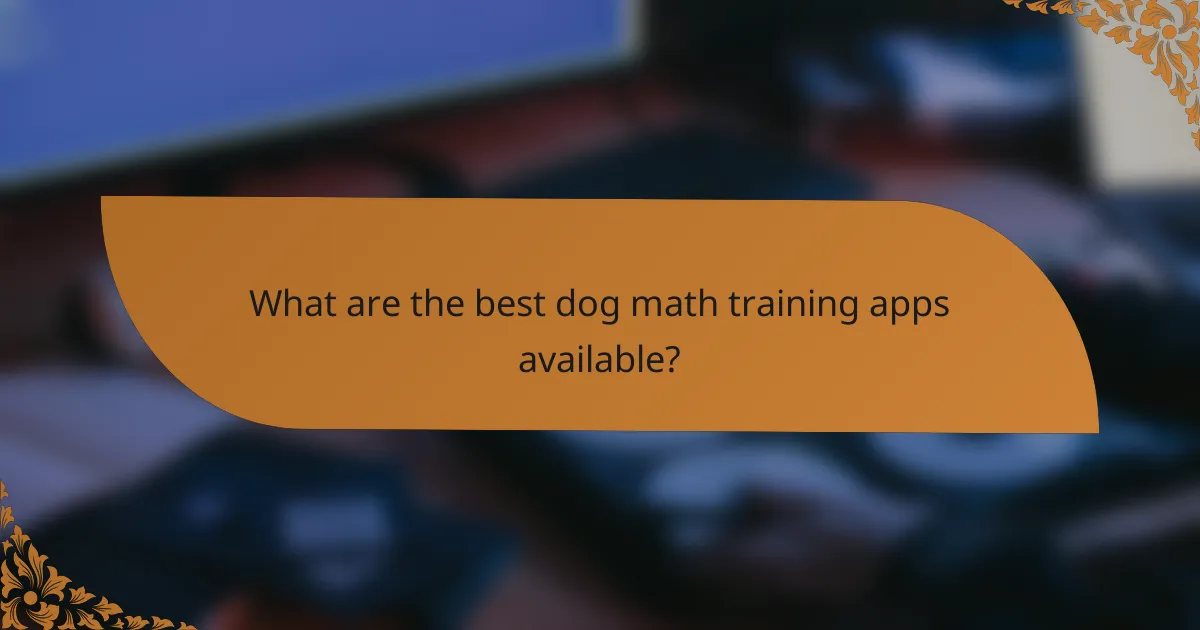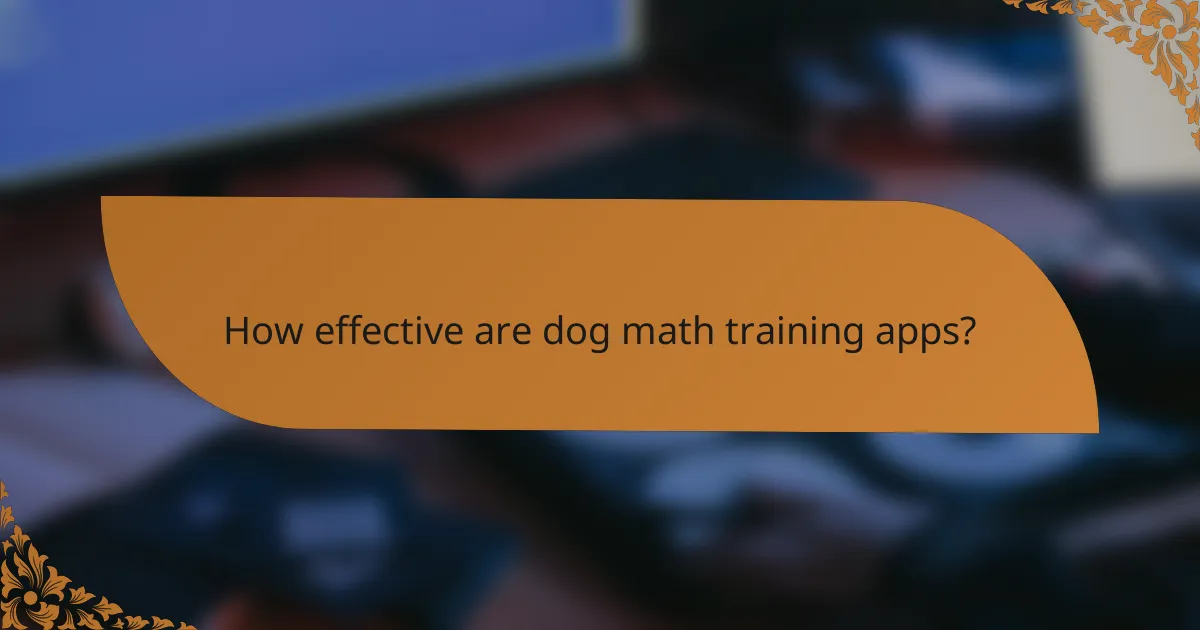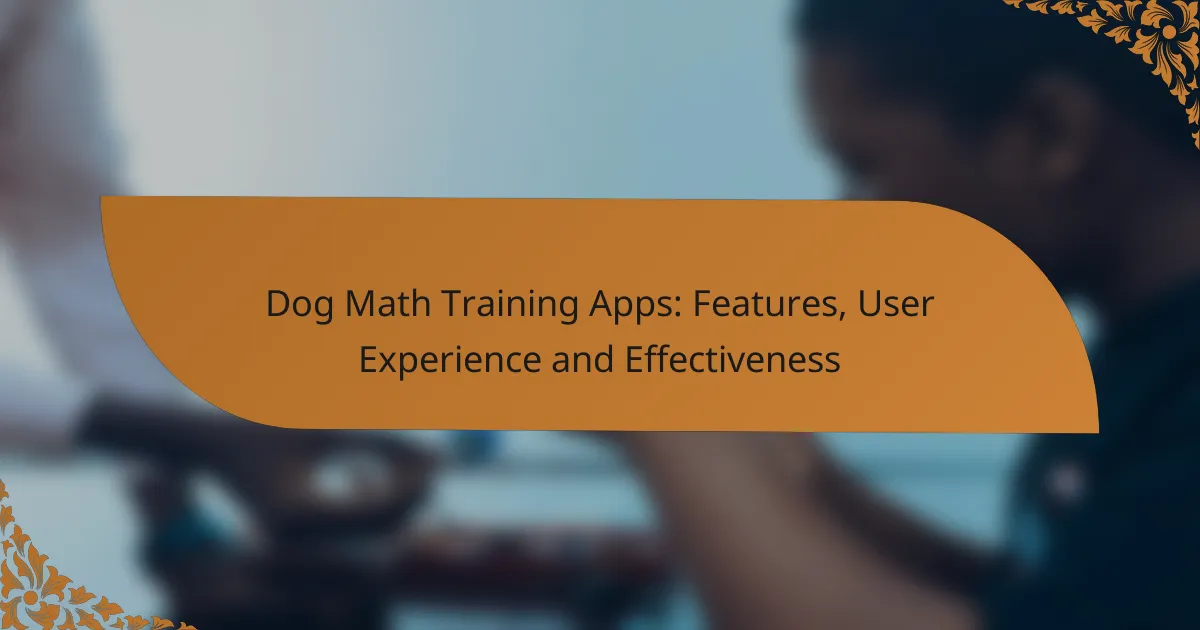Dog math training apps are designed to teach basic math concepts to dogs through engaging activities and effective learning techniques. With a variety of features and user experiences available, it’s important to choose an app that aligns with your training style and meets your dog’s specific needs. These apps not only enhance cognitive skills but also promote problem-solving abilities through interactive games and positive reinforcement.

What are the best dog math training apps available?
The best dog math training apps combine engaging activities with effective learning techniques to teach dogs basic math concepts. These apps vary in features, user experience, and effectiveness, making it essential to choose one that fits your training style and your dog’s needs.
Dog Trainer Pro
Dog Trainer Pro is designed for dog owners looking to enhance their pets’ cognitive skills through interactive math games. The app offers a variety of exercises that challenge dogs to solve simple arithmetic problems using visual cues and rewards.
Consider using Dog Trainer Pro if you prefer a structured program with step-by-step guidance. It includes progress tracking features that help you monitor your dog’s learning journey, making it easier to adjust training methods as needed.
PawMath
PawMath focuses on teaching dogs basic math operations through fun and engaging activities. The app utilizes a combination of visual stimuli and auditory cues to keep dogs motivated while they learn.
This app is particularly useful for owners who want to incorporate math training into daily routines. Its user-friendly interface allows for quick setup and easy navigation, ensuring that both you and your dog can enjoy the learning process without frustration.
Canine Calculators
Canine Calculators offers a unique approach by integrating math problems with physical tasks. Dogs are prompted to perform specific actions based on the math challenges presented, reinforcing both mental and physical engagement.
This app is ideal for active dogs that thrive on movement. By combining math with physical activity, Canine Calculators helps maintain your dog’s interest while promoting overall fitness and mental sharpness.
Smart Dog Trainer
Smart Dog Trainer emphasizes personalized training plans tailored to your dog’s learning pace. The app includes various math challenges that adapt based on your dog’s performance, ensuring a customized experience.
Utilize Smart Dog Trainer if you seek a flexible training solution that evolves with your dog’s abilities. The app’s analytics feature allows you to track progress and make informed decisions about future training sessions.
Math for Dogs
Math for Dogs is designed to make learning math enjoyable through gamified experiences. The app features a range of levels, from basic addition to more complex problems, catering to dogs of all skill levels.
This app is perfect for owners who want to introduce math concepts gradually. Its engaging format encourages repeated practice, which is essential for reinforcing learning and ensuring long-term retention of skills.

How effective are dog math training apps?
Dog math training apps can be quite effective in enhancing your dog’s cognitive skills and problem-solving abilities. These apps typically use interactive games and exercises designed to engage dogs and promote learning through positive reinforcement.
Research findings on effectiveness
Studies indicate that dog math training apps can improve a dog’s ability to recognize numbers and solve basic mathematical problems. Research shows that dogs trained with these apps often demonstrate enhanced memory and learning capabilities compared to those that do not use such tools.
However, the effectiveness can vary based on the dog’s age, breed, and prior training experience. Younger dogs and those with a background in training tend to show more significant improvements, while older dogs may require more time to adapt to the app’s exercises.
User testimonials and success stories
Many dog owners report positive experiences with math training apps, noting that their pets quickly grasped concepts and enjoyed the interactive nature of the games. Users often share stories of their dogs successfully completing tasks that involve counting or recognizing patterns, which boosts their confidence and engagement.
Success stories frequently highlight the bond formed between owners and their dogs during training sessions. Owners appreciate the opportunity to spend quality time with their pets while also providing mental stimulation, leading to happier and more well-rounded dogs.

What features should I look for in a dog math training app?
When selecting a dog math training app, focus on features that enhance engagement and track progress effectively. Key elements include interactive exercises, progress tracking, a user-friendly interface, and customizable training plans.
Interactive exercises
Interactive exercises are essential for keeping your dog engaged during training. Look for apps that offer a variety of fun and stimulating activities, such as puzzles or games that require your dog to solve math challenges. These exercises should adapt to your dog’s skill level, providing both challenges and rewards.
For example, an app might present simple addition tasks using treats, where your dog must choose the correct number of treats from a selection. This not only reinforces math skills but also makes learning enjoyable for your pet.
Progress tracking
Progress tracking features allow you to monitor your dog’s improvement over time. A good app should provide visual representations of your dog’s performance, such as graphs or charts, showing how they are advancing in their math skills. This helps you identify areas where your dog excels or may need more practice.
Consider apps that offer milestones or achievements to motivate both you and your dog. For instance, reaching a certain level of proficiency could unlock new exercises or rewards, making the training process more engaging.
User-friendly interface
A user-friendly interface is crucial for ease of use, especially when you are busy training your dog. The app should have intuitive navigation, allowing you to quickly access exercises, track progress, and customize settings without frustration. Look for apps with clear instructions and minimal distractions.
Additionally, consider apps that are compatible with various devices, such as smartphones and tablets, so you can train your dog anywhere. A clean design with large buttons and readable text can significantly enhance your training experience.
Customizable training plans
Customizable training plans enable you to tailor the learning experience to your dog’s unique needs and abilities. Choose an app that allows you to adjust the difficulty of exercises and set specific goals based on your dog’s progress. This personalization can lead to more effective training outcomes.
For instance, if your dog masters basic addition, you should be able to increase the complexity by introducing subtraction or multiplication tasks. This flexibility ensures that your dog remains challenged and engaged throughout their learning journey.

How do user experiences vary across different apps?
User experiences with dog math training apps can differ significantly based on factors such as functionality, ease of use, and engagement levels. Users often report varying satisfaction levels, which can influence their choice of app for training their pets.
User reviews and ratings
User reviews and ratings provide insight into the effectiveness and enjoyment of different dog math training apps. Many users express appreciation for apps that offer interactive features and clear instructions, while others may criticize apps for lacking engaging content or having technical issues. Ratings typically range from 3 to 5 stars, with higher-rated apps often featuring user-friendly designs and comprehensive training modules.
When evaluating apps, consider checking platforms like Google Play or the Apple App Store for the latest user feedback. Look for apps with consistent positive reviews, particularly those highlighting successful training outcomes.
Comparison of user interfaces
The user interface (UI) of dog math training apps plays a crucial role in overall user experience. Apps with intuitive layouts and easy navigation tend to receive better feedback, as users can quickly access training modules and track their dog’s progress. Features like customizable settings and visually appealing designs can enhance engagement and make learning more enjoyable for both dogs and their owners.
For example, some apps utilize gamification elements, such as rewards and challenges, which can motivate users to practice regularly. In contrast, apps with cluttered interfaces or complicated navigation may frustrate users, leading to lower satisfaction and reduced training effectiveness.

What are the pricing models for dog math training apps?
Dog math training apps typically follow several pricing models, including free options, subscription plans, and one-time purchases. Each model offers different features and user experiences, allowing pet owners to choose what best fits their needs and budget.
Free vs. paid options
Free dog math training apps often provide basic features, allowing users to test the app’s functionality without any financial commitment. However, these apps may include ads or limited access to advanced training modules.
Paid options generally offer a more comprehensive experience, including additional features such as personalized training plans, progress tracking, and ad-free usage. Users should weigh the benefits of enhanced features against their budget when deciding between free and paid apps.
Subscription plans
Subscription plans for dog math training apps usually charge users on a monthly or annual basis, providing continuous access to all features and updates. This model can be beneficial for users who want to ensure their training methods remain current and effective.
When considering subscription plans, users should look for options that offer a free trial period. This allows them to evaluate the app’s effectiveness before committing to a longer-term payment plan.
One-time purchase apps
One-time purchase apps require users to pay a single fee upfront, granting lifetime access to the app’s features. This model can be appealing for those who prefer not to deal with recurring payments.
However, users should check whether one-time purchase apps receive regular updates or additional content, as some may become outdated over time. It’s important to read reviews and ensure the app’s longevity before making a purchase.

What prerequisites should I consider before using a dog math training app?
Before using a dog math training app, consider your dog’s age, breed, and prior training experience. These factors can significantly influence how effectively your dog engages with and learns from the app.
Dog’s age and breed
The age and breed of your dog play crucial roles in determining their ability to learn through a math training app. Younger dogs, typically under two years, may have more energy and curiosity, making them more receptive to interactive learning methods. However, older dogs may have established habits that could affect their willingness to engage.
Different breeds also have varying levels of intelligence and trainability. For instance, breeds like Border Collies and Poodles are known for their quick learning abilities, while others may require more patience and tailored approaches. Assess your dog’s characteristics to choose an app that aligns with their learning style.
Before starting, ensure that your dog is physically and mentally prepared. A brief assessment of their attention span and interest in interactive activities can help gauge their readiness for math training. If your dog shows signs of boredom or frustration, consider adjusting the training approach or taking breaks as needed.
